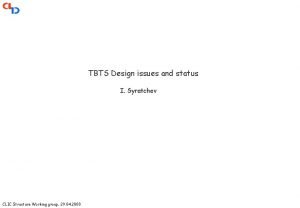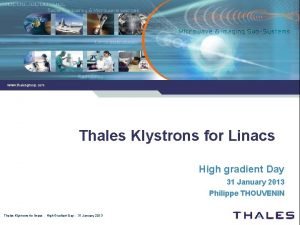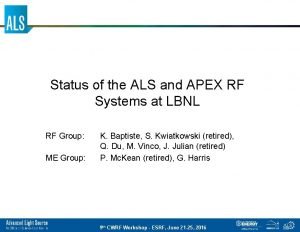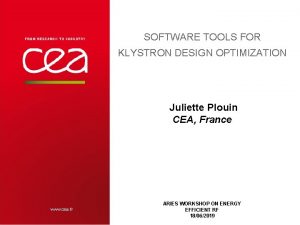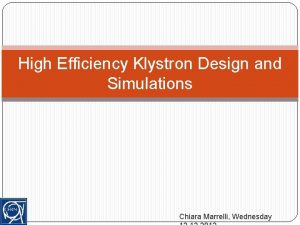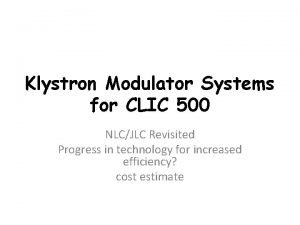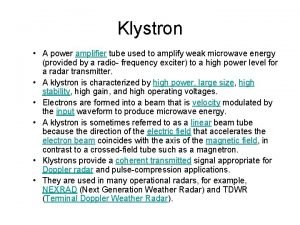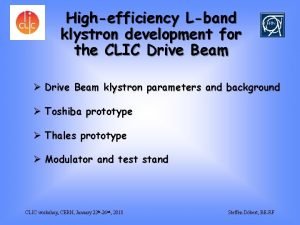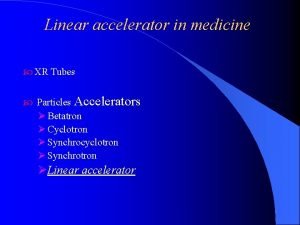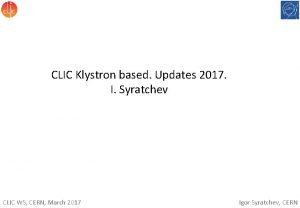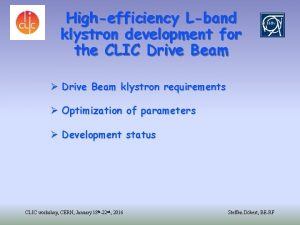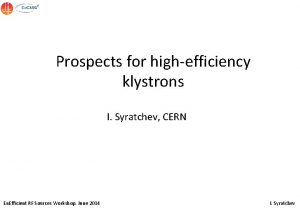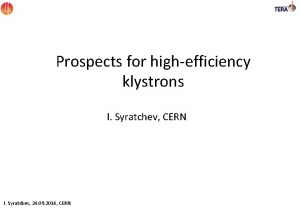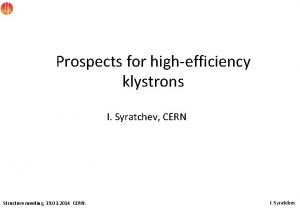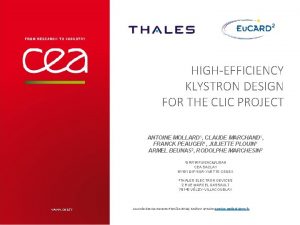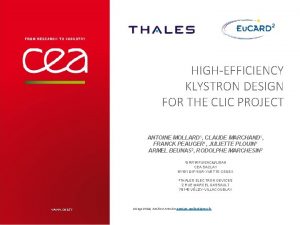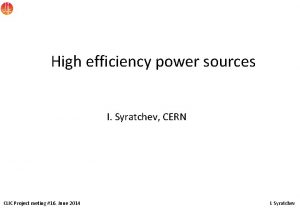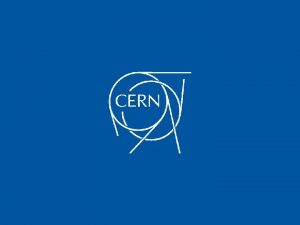HighEfficiency Klystron Development I Syratchev CERN CLIC Workshop












- Slides: 12

High-Efficiency Klystron Development I. Syratchev, CERN CLIC Workshop 2015. CERN, 27. 01. 2015. I. Syratchev. BE/RF

State of art: L-band 10 MW MBK klystrons for ILC. In terms of achieved efficiency at 10 MW peak RF power level, the existing MBK klystrons provides values very close to the 70%, as is specified in CLIC CDR. CLIC Workshop 2015. CERN, 27. 01. 2015. I. Syratchev. BE/RF

Optimising the klystron AJDISK (1 -beam klystron optimised by C. Marrelli) �� Perveance = 0. 21 Pout ≈ 2. 3 MW Efficiency 78. % The tuning of all parameters is done to provide the highest bunched current harmonics at the entrance of each consequent cavity. CLIC Workshop 2015. CERN, 27. 01. 2015. I. Syratchev. BE/RF

Scaling of the klystron parameters Design values are in black To go higher in efficiency, the intrinsic limits of the bunching processes and deceleration in the output cavity need to be understood at the level of the electron bunch dynamic. CLIC Workshop 2015. CERN, 27. 01. 2015. I. Syratchev. BE/RF

Electron velocity/density Personal recollection of the process in the high efficiency klystron (for illustration only) The fully saturated (FS) bunch CLIC Workshop 2015. CERN, 27. 01. 2015. Final compression and bunch rotation prepare congregating FS bunch. After deceleration all the electrons have identical velocities. Mission accomplished I. Syratchev. BE/RF

90% efficient klystron. To achieve very high efficiency, peripheral electrons should receive much stronger relative phase shift than the core electrons and this could happens only, if the core of the bunch experiences oscillations due to the space charge forces, whilst the peripherals approach the bunch centre monotonously. CLIC Workshop 2015. CERN, 27. 01. 2015. I. Syratchev. BE/RF

The optimal klystron with maximal efficiency. Glossary: 1) Relativistic extension of the perveance: 2) space charge parameter: 3) Lumped bunching length (LBL): ( -drift tube filling factor) (l - the total length of drift tubes and cavities gaps) Results of optimisation of the two different klystrons: type#1 type#2 Recipe: 1. The maximal attainable efficiency depends on the klystron configuration N (number of cavities). 2. For every klystron configuration, the klystron length and perveance should be compromised in order to keep the LBL around its optimal value: l opt. ~ N-1. 3. For the 7 cavities klystron, the electron efficiency is close to 96%, thus further increasing of the number of cavities does not look practical. CLIC Workshop 2015. CERN, 27. 01. 2015. I. Syratchev. BE/RF

20 MW, 1 GHz MBK for CLIC with core oscillations. Preliminary study. N beams = 8 V = 180 k. V I total = 128 A RF extraction efficiency: 89. 6%; l opt. =4. 75 Bunching quality at the entrance of the output cavity for the klystrons with similar parameters. Optimisation with bunch core oscillations method Normalised velocity RF=78. 0% /2 RF period, rad CLIC Workshop 2015. CERN, 27. 01. 2015. Normalised velocity Optimisation with maximising the RF current harmonics (see p. 3) RF=89. 6% RF period, rad I. Syratchev. BE/RF

Comparison of the two bunching methods. Core oscillations RF current harmonics Ø For the ultimately high efficiency, technical implementation of the bunching method with core oscillations will require substantial increase of the bunching length. Ø The observed efficiency degradation up to perveance as high as 1 10 -6 appeared to be rather small (about 3%). Ø This results also imply that reducing the klystron perveance is not the necessary condition to achieve very high, above 80%, efficiency. CLIC Workshop 2015. CERN, 27. 01. 2015. I. Syratchev. BE/RF

Towards 60 k. V, 20 MW, 1 GHz MBK for CLIC 1. If the efficiency just above 85% is considered, then the operating perveance can be chosen high enough - between 0. 5 10 -6 and 1 10 -6. Example: K=0. 83 10 -6; =87%; l =2. 63 m. 2. The reduction of operating voltage from 180 k. V down to 60 k. V with fixed l opt. =4. 75, decreases the klystron length by about 35%: 1. 73 m. Whilst the total current is increased by the same factor 3 and the number of beams needed is 36: With 60 k. V operating voltage: § The are no needs for the pulsed transformer. § The are no needs for the oil tank for high-voltage components and for the tube socket. § The modulator switching circuit will be simplified. CLIC Workshop 2015. CERN, 27. 01. 2015. I. Syratchev. BE/RF

Roadmap for high-efficiency high RF power klystron development L-band, CW/long pulse FCC, ESS <20 beams; <50 k. V 3 years Optionally – gun with controlled electrode (2. 5 k. V) 3 years L-band. CLIC. 40 beams; 60 k. V 1. 0 year S-band Demonstrator 40 beams; <60 k. V L-band ILC 6 beams; 116 k. V X-band Kladistron L-band CLIC 6 -10 beams; ~160 k. V 1. 0 year Exists 2 CLIC Workshop 2015. CERN, 27. 01. 2015. 6 20 40 I. Syratchev. BE/RF

Special thanks to: Andrey Baikov & Chiara Marrelli CLIC Workshop 2015. CERN, 27. 01. 2015. I. Syratchev. BE/RF
